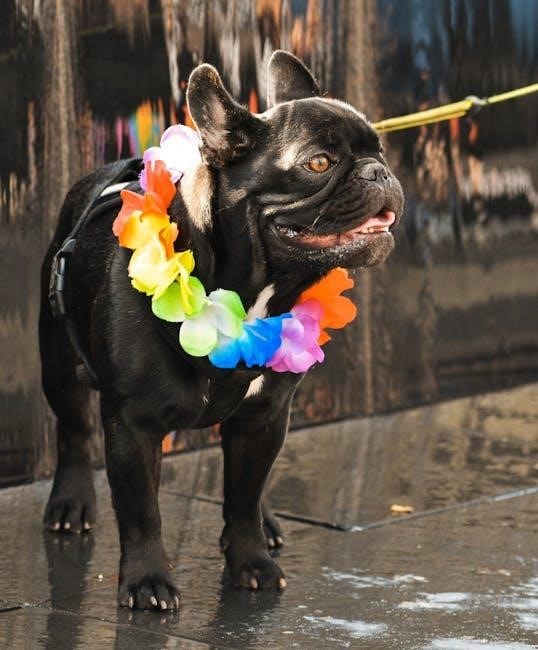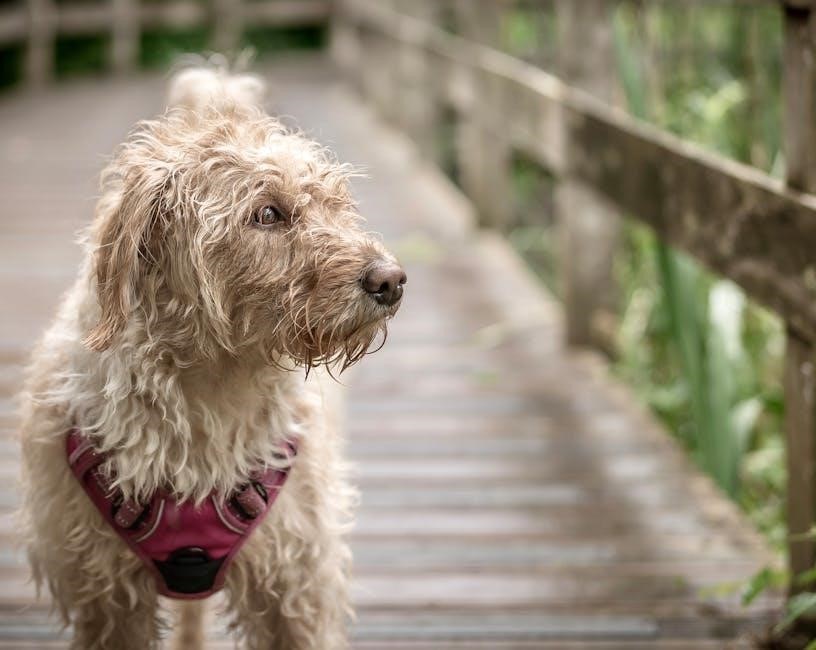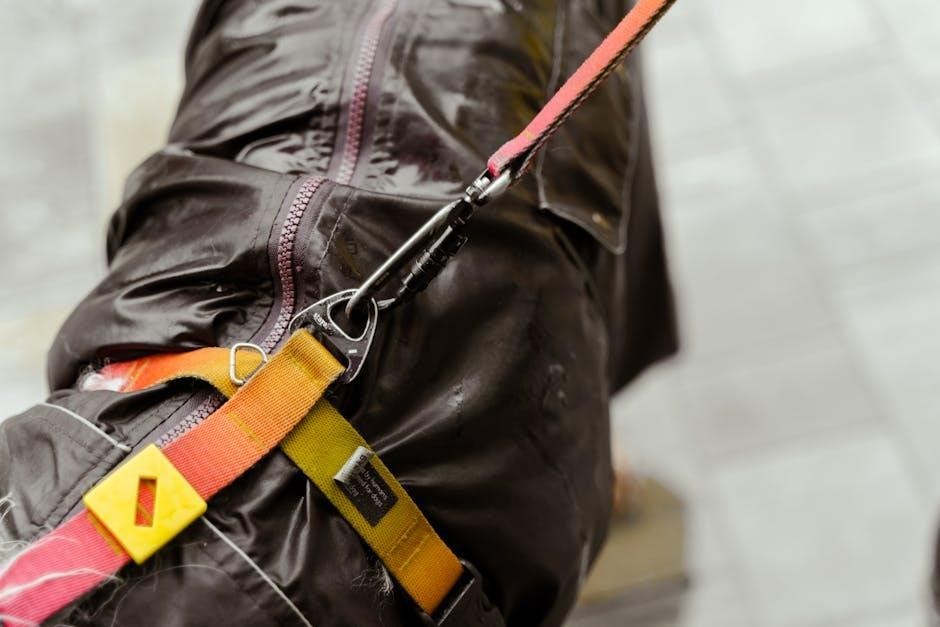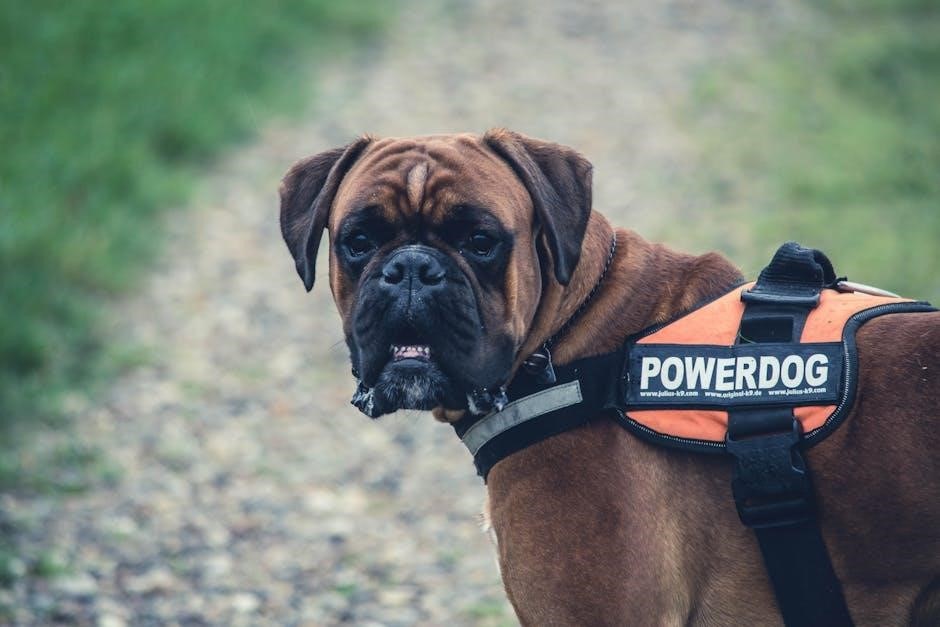dog guide harness
A dog guide harness is a specially designed tool that enhances control, comfort, and safety for both dogs and their handlers during walks or tasks.
What is a Dog Guide Harness?
A dog guide harness is a specialized tool designed for service dogs to assist visually impaired individuals. It provides enhanced control, comfort, and safety during navigation. Made from durable materials like leather or nylon, these harnesses feature padded handles and adjustable straps for a secure fit. They are engineered to distribute force evenly, ensuring the dog’s comfort during long tasks. Unlike regular pet harnesses, guide dog harnesses are built for specific tasks, offering reliability and durability for both the dog and handler.
Importance of Dog Guide Harnesses
Dog guide harnesses are essential tools for service dogs, enabling them to assist visually impaired individuals safely and effectively. These harnesses provide enhanced control, ensuring smooth navigation in various environments. By distributing force evenly, they prevent discomfort or injury to the dog, while their durable construction guarantees reliability. The harness’s handle and straps are designed for clear communication between the dog and handler, fostering trust and independence. Their importance lies in their ability to empower both the dog and handler, making daily tasks more manageable and fostering a stronger bond between them. They are indispensable for mobility and independence.
Brief History and Evolution
The concept of dog guide harnesses dates back to the early 20th century, when guide dogs first began assisting visually impaired individuals. Initially, simple leather straps were used, focusing on basic control. Over time, advancements in materials and design led to more ergonomic and durable options. The 1960s and 1970s saw the introduction of synthetic materials, enhancing comfort and adjustability. Modern harnesses now incorporate innovative features like padded handles and breathable fabrics, prioritizing both functionality and the dog’s well-being. This evolution reflects a growing understanding of the critical role these tools play in enabling independence and mobility for their users.

Types of Dog Guide Harnesses
Dog guide harnesses come in various styles, including no-pull, leather, tactical, and specialty designs, each tailored for specific needs, ensuring comfort, control, and durability for both dog and handler.
No-Pull Dog Harnesses
No-pull dog harnesses are designed to reduce pulling behavior by distributing force across the dog’s chest and shoulders. They often feature front-clip attachments, discouraging pulling without causing discomfort. Popular models like the Blue-9 Balance Harness are praised for effectiveness and comfort. These harnesses are ideal for dogs that pull excessively, offering a safe and humane solution. They are recommended by trainers and dog walkers, promoting a more enjoyable walking experience for both the dog and handler while aiding in behavioral training.
Leather Dog Guide Harnesses
Leather dog guide harnesses are durable, stylish, and ideal for service or guide dogs. They offer superior comfort and control, with adjustable straps for a secure fit. The Peshouco Handmade Leather Dog Harness is a top choice, known for its high-quality craftsmanship. These harnesses often feature padded interiors and sturdy handles, ensuring longevity and ease of use. Leather harnesses are preferred for their classic look and durability, making them a reliable option for guide dogs and their handlers. They are also easy to maintain with proper conditioning, ensuring they remain a long-lasting investment.
Tactical Dog Harnesses
Tactical dog harnesses are designed for durability and maximum control, making them ideal for active tasks and training. They often feature no-pull designs and side pockets for carrying gear, enhancing functionality. Constructed from sturdy materials like nylon, these harnesses are built to withstand rigorous use. Popular among trainers and handlers, they provide a secure fit and excellent control, ensuring both dog and handler can perform effectively in demanding situations. Tactical harnesses are a versatile choice for dogs engaged in active roles or adventures, offering both comfort and practicality for enhanced performance.
Specialty Harnesses for Guide Dogs
Specialty harnesses for guide dogs are tailored to assist visually impaired individuals, offering enhanced communication and navigation support. These harnesses often feature unique padding and ergonomic designs for extended comfort during long walks. Advanced models, like the UniFly harness, act as a direct line of communication between the dog and handler, ensuring seamless teamwork. Some include GPS integration and reflective materials for added safety. Designed for both functionality and durability, these harnesses play a vital role in empowering guide dogs to confidently lead their handlers through various environments, fostering independence and trust.

Features to Consider
Key features include adjustable straps for a perfect fit, durable materials for longevity, and padded areas for comfort. Handles and control options enhance manageability and safety.
Adjustable Straps and Fit
Adjustable straps are a crucial feature of dog guide harnesses, ensuring a customized fit that prevents discomfort or restricted movement. Proper fit is essential for effective control and safety, as a harness that is too tight or too loose can be unsafe. High-quality materials, such as durable nylon or leather, provide both strength and flexibility. For optimal comfort, look for padded straps and a breathable design that accommodates your dog’s body shape. Regular adjustments may be needed to account for weight changes or seasonal variations in clothing. A well-fitted harness enhances both the dog’s comfort and the handler’s control.
Durable Materials and Construction
Durable materials and construction are essential for dog guide harnesses, ensuring longevity and reliability. High-quality options like leather or heavy-duty nylon are commonly used, offering strength and resistance to wear. Reinforced stitching and robust hardware, such as metal or durable plastic buckles, enhance the harness’s structural integrity. Padded areas and ergonomic designs provide comfort while maintaining durability. For guide dogs, the harness must withstand daily use and varying conditions, making materials like weather-resistant nylon or double-layered leather ideal choices. A well-constructed harness ensures safety and performance, making it a vital tool for both dog and handler.
Handles and Control Options
Handles and control options in dog guide harnesses are crucial for effective communication between the dog and handler. Fixed semi-rigid handles provide stability, while padded handles enhance comfort during use. Adjustable handles allow customization to suit individual preferences. Some harnesses feature dual handles for added control, especially in challenging situations. Additional control options include side pockets for accessories and no-pull designs that distribute force evenly. These features ensure precise control, enabling smooth navigation and safe handling. High-quality handles and control mechanisms are essential for the harness’s functionality and the handler’s confidence.
Padding and Comfort
Padding and comfort are essential for a dog guide harness to ensure long-lasting wear and optimal performance. High-quality materials, such as fleece or gel padding, are often used to cushion areas like the chest and shoulders, reducing friction and pressure points. Breathable fabrics help prevent overheating, while reinforced padding in high-stress zones enhances durability. Proper fit and adjustable straps also contribute to comfort, allowing for a full range of motion. A well-padded harness not only protects the dog but also ensures a pleasant experience for the handler, fostering trust and effective communication during tasks.

How to Choose the Right Harness
Selecting the right dog guide harness involves assessing your dog’s size, activity level, and specific needs, ensuring a balance of comfort, durability, and functionality for effective guidance.
Assessing Your Dog’s Needs
Understanding your dog’s specific requirements is crucial when selecting a guide harness. Consider their size, breed, and activity level to ensure proper fit and comfort. For active dogs, durable materials like leather or nylon are ideal, while lighter options may suit calmer breeds. Additionally, think about the intended use—whether for daily walks, training, or specialized tasks. Evaluating these factors helps narrow down the choices, ensuring the harness provides optimal support and functionality for both the dog and handler, enhancing their working relationship and overall experience.
Measuring for the Correct Size
Proper fit is essential for a dog guide harness to ensure comfort and functionality. Measure your dog’s girth, the circumference of their chest just behind the front legs, using a flexible tape measure. Ensure the harness is snug but not restrictive, allowing for a full range of motion. Incorrect sizing can lead to discomfort or reduced control. Adjustable straps are a key feature, enabling precise tailoring to your dog’s body. Always refer to the manufacturer’s sizing chart and consider your dog’s growth or weight changes to maintain the ideal fit over time.
Reading Reviews and Recommendations

Reading reviews and recommendations is crucial when selecting a dog guide harness. Insights from professional trainers, handlers, and other users provide valuable perspectives on comfort, durability, and functionality. Look for feedback on specific features like adjustable straps, padding, and handle design. Recommendations often highlight top-rated models, such as the Blue-9 Balance Harness or Julius K9 IDC, known for their no-pull efficiency and durability. Pay attention to how well a harness performs in real-world scenarios, ensuring it aligns with your dog’s needs and activities. This step helps narrow down options and ensures a well-informed decision for both you and your dog.

Maintenance and Care

Regular cleaning, conditioning, and proper storage extend the life of a dog guide harness. Inspect for wear and tear to ensure safety and durability over time.
Cleaning and Conditioning
Regular cleaning is essential to maintain the integrity of a dog guide harness. For leather harnesses, use mild soap and water, avoiding harsh chemicals that can damage the material. Nylon harnesses can be wiped with a damp cloth or gently scrubbed with a soft brush. Always air-dry the harness to prevent mold or cracking. For conditioning, apply a leather conditioner to keep the material supple and durable. Avoid machine washing, as it can cause wear and tear. Proper care ensures the harness remains comfortable and functional for your dog.
After cleaning, inspect for any signs of damage or fraying. Conditioning leather harnesses regularly helps prevent cracking and extends their lifespan. For nylon, a fabric conditioner can enhance softness and durability. Always follow the manufacturer’s care instructions to ensure optimal maintenance. Proper cleaning and conditioning not only prolong the harness’s life but also ensure your dog’s comfort and safety during use.
Storage and Longevity Tips
To extend the life of your dog guide harness, store it in a cool, dry place away from direct sunlight. Avoid folding or creasing leather harnesses, as this can cause permanent damage. For nylon harnesses, hang them to maintain their shape and prevent stretching. Regularly inspect the harness for wear and tear, addressing any issues promptly. After use, allow the harness to air-dry thoroughly to prevent mildew. Proper storage and care ensure the harness remains durable and comfortable for your dog, maintaining its functionality over time.
Regular Inspections
Regular inspections of your dog guide harness are crucial to ensure its safety and functionality. Check for signs of wear, such as frayed straps, loose buckles, or cracked leather. Pay attention to high-stress areas like the handle and chest plate. For nylon harnesses, look for abrasions or tears that could weaken the material. Leather harnesses should be conditioned to prevent drying out and cracking. Inspect the padding for compression or degradation, as this affects comfort and support. Daily quick checks and monthly in-depth inspections can prevent potential issues. Neglecting inspections may lead to equipment failure, compromising both the dog’s and handler’s safety.

Legal and Regulatory Considerations
Understanding legal requirements for dog guide harnesses ensures compliance with service animal laws, accessibility standards, and public safety regulations, while promoting responsible ownership and societal acceptance.
Service Dog Harness Requirements
Service dog harnesses must meet specific criteria to ensure functionality and identification. They should be durable, with clear markings like “Service Dog” or “Guide Dog” to signify their purpose. Handles and straps must be adjustable for a secure fit, while padding ensures comfort during long tasks. Compliance with ADA standards is essential, allowing access to public spaces without obstruction. Proper certification and vet documentation are often required to validate the dog’s role as a service animal. Regular inspections and maintenance are crucial to uphold both form and function, ensuring reliability in assisting handlers effectively.
Guide Dog Harness Standards
Guide dog harnesses must adhere to strict standards ensuring safety, durability, and functionality. They should distribute weight evenly, reducing strain on the dog, while providing clear identification as a working animal. Handles must be sturdy and ergonomic, allowing precise control. The harness should be easily adjustable to fit the dog comfortably, with padding in key areas to prevent chafing. Reflective elements are often required for visibility, and the design should allow for smooth communication between the dog and handler. Compliance with international accessibility standards ensures seamless navigation in public spaces, while regular inspections maintain the harness’s integrity and performance over time.

Training with a Dog Guide Harness
Training with a dog guide harness begins with gradual introduction, ensuring comfort and familiarity. Basic commands like “sit,” “stay,” and “walk” are essential for effective communication.
A dog guide harness is a specially designed vest-like accessory that provides control, support, and comfort for dogs during walks or specific tasks. It distributes pressure evenly across the chest and shoulders, reducing strain on the neck. Unlike collars, harnesses are ideal for dogs that pull or have respiratory issues. They often feature adjustable straps, durable materials, and padding for comfort. Proper fit is crucial to ensure the dog’s mobility and handler’s control. Harnesses are widely used for service, therapy, and guide dogs, as well as for pets, offering practicality and safety for both the dog and handler.
Basic Obedience Commands
Teaching basic obedience commands is essential for effective use of a dog guide harness. Commands like heel, sit, stay, forward, and stop help establish clear communication. These commands ensure the dog remains focused and responsive, especially in public settings. Heel is crucial for maintaining a steady pace, while sit and stay provide control in stationary situations. Leave it prevents distractions, and forward aids in navigating. Consistent training reinforces these commands, enhancing the dog’s ability to work effectively with the harness and handler, ensuring safety and efficiency in daily tasks.
Advanced Training Techniques
Advanced training techniques with a dog guide harness focus on refining skills for complex situations. Techniques include figure-eight exercises to navigate obstacles, spiral patterns for tight spaces, and distraction training in busy environments. Handlers learn to guide their dogs through crowded areas, stairs, and uneven terrain. These exercises enhance the dog’s ability to respond accurately under various conditions. Tools like clickers and verbal cues are often used to reinforce precise movements. Regular practice strengthens the bond between dog and handler, ensuring seamless communication and effectiveness in real-world scenarios, making advanced techniques indispensable for reliable guidance and safety.

Future Trends
Future trends in dog guide harnesses include innovative materials, such as lightweight, breathable fabrics, and technology integration, like GPS and sensors for enhanced functionality and safety.
Innovative Materials and Designs
Innovative materials like breathable mesh and lightweight nylon are revolutionizing dog guide harnesses, offering improved comfort and durability. Design advancements include ergonomic shapes that reduce pressure points and adjustable straps for a customized fit. Some harnesses now feature water-resistant coatings and reflective elements for enhanced visibility. These designs not only prioritize the dog’s well-being but also provide handlers with greater control and convenience. Such innovations ensure that guide harnesses meet the diverse needs of service dogs and their owners, making them more effective and user-friendly.
Technology Integration
Modern dog guide harnesses are increasingly incorporating technology to enhance functionality. Features like GPS tracking and heart rate monitors provide real-time data on the dog’s condition. Some harnesses now include smart sensors that detect stress or fatigue, ensuring better care for working dogs. Additionally, communication devices integrated into the harness allow handlers to receive vital information, such as navigation cues or environmental alerts. These advancements not only improve safety but also strengthen the bond between guide dogs and their handlers, making their partnerships more efficient and effective in diverse situations.
Dog guide harnesses are vital tools that enhance independence and safety for both dogs and handlers, offering comfort, control, and durability for various tasks and activities.
Final Thoughts
Dog guide harnesses are indispensable tools that empower both dogs and handlers, offering unmatched versatility, comfort, and control. Whether for service, therapy, or mobility assistance, these harnesses provide practical solutions. From durable leather designs to innovative tactical models, their adaptability meets various needs. The balance of functionality and comfort ensures long-term usability. As technology advances, future designs promise even greater benefits. Investing in a high-quality harness is a commitment to safety, independence, and a stronger bond with your canine companion. Explore further to find the perfect fit for your dog’s unique requirements and activities.
Encouragement to Explore Further
Exploring the world of dog guide harnesses opens up a wealth of possibilities for enhancing your dog’s comfort, safety, and performance. Whether your dog serves as a service animal, therapy companion, or beloved pet, the right harness can make a significant difference. Researching different styles, materials, and features will help you find the perfect match for your dog’s unique needs. Consider reaching out to professionals, reading reviews, and trying out options to ensure the best fit. Investing time in this process will reward you and your dog with countless enjoyable adventures together.
